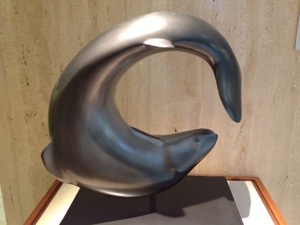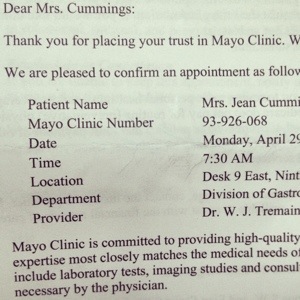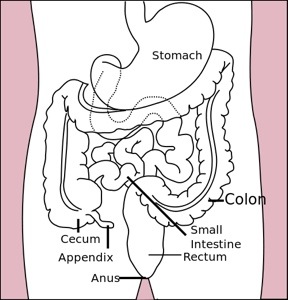Having returned from Mayo, I want to post a quick update…. I’m good, under the circumstances—not going to let having this disease change things too much. I saw my GI at Dartmouth yesterday. He was surprised I went to the Mayo Clinic, but understands how seriously I consider taking DNA-altering drugs, and drugs that affect my immune system, etc. His colleague, Corey Siegel, is doing a study of using a different kind of Tumor Necrosis Factor (Alpha) inhibitor (big fancy words I am loving to say, but suffice it to say it is human and not mouse-tissue based); the results of which will be available in a few weeks. They want me to wait since I have no symptoms, and waiting is what I do best!
Dr. Bensen said if I take the drugs, they are seeing the best results with the TNF(A) Biologic (he mentioned Humira) (also Remicade and Cimzia), combined WITH the immunomodulator, 6MP, for the best results for full remission, at 40-60%. He said if I take the Imuran alone, my chances of getting results are not as efficacious. This, I do understand. He feels the Mayo Clinic’s recommendations are not fully in line with his, and Corey Siegel’s, “front-line” offense approach.
~
In the meantime, I am (seriously!) looking into taking whipworms….you know how much I love creepy crawly things! Seriously, there is a new study, and you can read about it here.
It is nice to be back home in Vermont…. The day I left Rochester, Minnesota, there was a blizzard and they got around 13 inches of snow in MAY!
I am working on a longer post about the stress reduction class I tool, the Eastern medicine and work of Amit Sood, MD, and the integrative medicine at the Mayo Clinic.
Here are a few more photos from Mayo (top, Fish, by Gordon Gund a patient; bottom statue study for the “Les Bourgeois de Calais,” by Aguste Rodin…a huge statue that is very powerful and stands in the middle of a busy atrium cafeteria looking anguished; and last but not least, the dancers I really fell in love with in the hallway near the blood work laboratories!)…
waiting for the doctor
April 30 Tuesday 4:30 PM
I am waiting for Dr. Jeffrey McCurdy and he will review my case with me.
Monday I had a CAT scan here at the Mayo Clinic. I had not eaten for 24 hours, due to the requirement to be fasting for my appointments. I think because of that, I ended up fainting.
I could tell I was feeling a little sick, and the staff was incredible — they were so wonderful. Anyway, I was wheeled into the CAT scan room, and my technician James even joked with me about me fainting (word had spread!).
They are all incredibly nice here at the Mayo Clinic. The buildings and the grounds are really quite spectacular. It reminds me of an unknown Mecca of sorts, or a place where people go to pilgrimage. It is interesting that my son, Sam, is on a pilgrimage called El Camino de Santiago, in Spain, at this time. There are so many people here, from all over the world—many of whom are very sick, or caring for a loved one who is sick—and there is a sense of the fragility of life around me here, but also the indomitable spirit of the patients in search of extending their lives or, as in my case, improving the quality of life.
So, while I’m waiting for Dr. McCurdy, I am prepared to take in the news that they will recommend that I take medication. On the other hand, they may suggest some alternatives. I have no idea!
After the affable, and highly intelligent 30-something, Jeffrey McCurdy, MD, arrived he sat down and showed me my blood work results (spectacular were his words!), and my CAT scan results (not so great, in his words), the medication, IMURAN, is recommended by the GI team here at the Mayo.
My Tpmp is normal, so they say I can take the maximum dosage. (Thiopurines are a class of drugs that suppress the immune system. Examples include azathioprine, mercaptopurine, and thioguanine. These medications are used to treat diseases such as acute lymphoblastic leukemia, inflammatory bowel disease, and autoimmune disorders. They may also be prescribed to patients who have had organ transplants to help delay or prevent organ rejection. This test detects the activity level of the enzyme thiopurine S-methyltransferase (TPMT) in a person’s red blood cells. The activity level of TPMT is associated with the ability to effectively metabolize thiopurines.)
Dr. McCurdy explained that I have a high “Rutgeerts” score of 3 on my colonoscopy, which is indicative of inflammation that they usually treat aggressively.
Blood work checks will be frequent to monitor my side effects. Uncommon side effects are rare, but can be severe. Flu-like symptoms (most common), headaches, joint pain can be severe, fevers, pancreatitis, elevated liver enzymes (blood work will be checked for this). There is also a possibility of a decrease in my white blood cell count, which helps you fight infection. They expect it will go down… Mine is currently at 6.4 Leukocytes (might go down as low as 3.0).
Very uncommon risks are as follows: Cancer risk for skin cancer, so skin exams yearly are recommended. Also, there is an slight increase in the possibility of lymphoma—When I asked him to explain, he provided an analogy of a busy street corner, with 2 out 10,000 passersby might have lymphoma. With IMURAN, this chance increases to 4 in 10,000.
Of more concern is the inflammation in my body. I can develop perforations, strictures, flistulas, and abscesses due to bowel perforations. Having active inflammations increases my risk of cancer, which is exceedingly uncommon in the small bowel, but worth noting. If Dr. McCurdy were in my shoes, he said he’d do both medications at once: Remicade and IMURAN. But, he also spent hours reviewing my case with Dr. Tremaine, and since I’ve been 7 years out of surgery, I have a better argument for not taking the two types of medications recommended by Dr. Corey Siegel at Dartmouth. In 2010, my histogic (tissue) endoscopic test was minimal, showing only 4 ulcers, scoring a “Rutgeerts” score of 1.
For me to decide medications, it is highly individualized, and they know I’m in line with alternative medicine. Given my individual history and predications, they recommend a one year duration with a colonoscopy to show results. (I.e., one year before investigations.) using the maximum dose of Imuran.
Right now, I would need to be on it indefinitely. When medication is stopped, the disease tends to comes back, and some people may no longer respond to that medication should they go off and develop a recurrence.
In Crohn’s disease, they know that for causes genetics is involved, and environmental factors. However, there is no known cause or cure. Parasites activate a certain arm of your immune disease, but it is very unlikely it would cause a disease such as Crohn’s. No single organism is ID’d as a causative agent. Fecal transplants and worm therapies are being studied. Only case studies available: meaning when studies are positive, they are quick to publish, so there is sometimes a publication bias. It is important to report positive-negative outcomes to determine efficacy. He said he worries about safety with introducing pathogens (like worms!); and they need more information on safety profiles.
The SCD diet (specific carbohydrate diet): science on this is not conclusive, according to Dr. McCurdy, and diet depends on state of bowel disease.
They know that for many patients animal fats, simple sugars, and shellfish can contribute to the disease. My disease is characterized by inflammation.
Dr. McCurdy has little experience with herbal remedies. He said to be careful with anti- inflammatories like Advil and Ibuprofen, because they can make Crohn’s worse.
Lots of his patients use Vitamin D (in patients that are deficient), with good results, but not using therapeutically, though there are recent studies on vitamin D and Crohn’s specifically.
If I wait, I’m running risk of developing strictures, flistulas, and a possible bowel obstruction. I already had an internal fistula in 2006, but I could develop cutaneous (out of skin), or vaginal, fistulas, or other connections from one organ to another, which are symptomatic of Crohn’s. again, he noted that I am symptom free, except for the endoscopic and CAT scan tests.
Dr. McCurdy just did a presentation on new therapies that use different mechanisms of action in clinical trials. These are years out, he said.
I have swollen lymph nodes around my disease site: any time you have inflammation, your immune system starts in the lymph nodes, like in a common cold when your lymph nodes swell. I have inflammation around 10 cm of the neo- terminal ileum.
They don’t want me to loose anymore small bowel because of problems with malabsorption, especially Vitamins and minerals.
So, that’s the report…I guess I was hoping that my CAT scan would have been better. It is really hard to live with a disease and not see improvements.
My next stop is the Integrative medicine round, and I will explore a lot of alternatives—for sure!
Stay tuned for Day 3, where I visit the Stress Reduction & Relaxation Clinic at the Mayo…
I am waiting for Dr. Jeffrey McCurdy at the Mayo Clinic — I will see him this morning April 29 at 8 AM.
I arrived last night at 6:00 pm at my hotel the Kahler Grand in Rochester Minnesota, having departed from Hartford airport in the afternoon. The flight was an easy three hour flight. The people here are extremely friendly so far.
I am not nervous, in fact I feel very confident. When I got here I was very impressed by the architecture and the huge buildings of the Mayo Clinic. Everything is so beautiful here: the artwork on the walls and the whole ambience of the place.
Dr. McCurdy was great. He’s from Canada. He is in his early 30s. He asked me tones of questions about the history of my disease. He was very thorough, and I got a complete physical exam.
My weight was 138, my blood pressure was normal, and my first rectal examination was normal. Around 40% of Crohn’s patients have some sort of anal-rectal problem. Things like fistulas or discharge. Luckily, for me, I do not have any problems there.
Enterography Is a possible test they might perform, according to Dr. McCurdy.
A new study from Rhode Island Hospital has found that MR enterography (MRE) without the use of an anti-peristaltic agent was as reliable as CT enterography (CTE, or CAT scan) in determining the presence of Crohn’s disease “without the use of an anti-peristaltic agent.”
In other words, this test exposure to ionizing radiation is less invasive, especially for children who are prone to absorbing more radiation than someone in their 50s like me!
Disease reccurrance after Crohn’s surgery is the rule, according to my doctor, at around 90%, and it comes back in 2-3 years. Patients can be asymptomatic but have disease.
I have gone 7 years!
Dr. McCurdy noted that “treating for mucosal healing is the best chance I have without complications.”
He also gave me my options and course of testing:
“So there are number of predictors that we have determining who’s going to have a more aggressive disease course: clinical predictors, imaging predictors. as well as other diagnostic tools.”
In the clinical predictors, he said, there are patients who have had several resections who have symptoms that come back immediately after the resection as well as people who don’t have any symptoms.
Endoscopic predictors (colonoscopies) are the best predictors of who will have no complications in the future.
In 2008, a Belgian clinician, Paul Rutgeerts, MD, developed an endoscopic score to predict who will develop problems in the future and it’s based on how much inflammation is found in the scope. So a Rutgeerts scored of 0 means zero inflammation; a Rutgers score of 1, which is what I had in 2010, showed some inflammation.
More than 5 ulcers and confluent inflammations — that would be a Rutgeerts score of 3 — that’s what I have now….A Rutgers score of 3 or 4: that’s when you start to get worried about future complications. Since I have a Rutgeerts score of 3, that predicts — with about 75% predictive value— that I will develop problems with Crohn’s disease in the future.
“So that’s what we have to go by,” he said, “and when you’re working with medications, you only think about people that need medications, and we also think about those clinical predictors, as well as disease recurrence in some patients that require surgery.”
If patients score less on the Rutgeerts scale, and they have a lower risk profile, they don’t need any medications; and in these patients that don’t take any medications, they scope from 6 to 12 months after surgery and look for that Rutgeerts score, which is what they’ve been doing with me up at Dartmouth.
I have no symptoms, but Dr.McCurdy said I have significant disease at this time, which is predictive of problems down the road.
The question they have now is how long has this disease been spreading, and how extensive it is.
The more extensive it is, the more aggressive they are with medications —if it’s a very small segment, then it is very reasonable to consider surgery, if I want, but the risk of surgical adhesions is high.
Dr. McCurdy will determine how long that segment is by doing what what’s called CT enterography which is a special scan to look at the small bowel.
“Okay, so what we should do this,” I added.
He said we should also get my biopsies from November, to look at the pathology slides to make sure that they confirm that this is Crohn’s disease and nothing else.
He added, “then I always do a routine blood test to check vitamin D levels and B12 levels, as that’s the area that’s been removed called the terminal ileum (he pronounced it with a long “I” sound and when I asked him, he said he is the only doctor who pronounces it “eye-leum”).
He added that whether we should be using medications, or whether we recommend surgery or no medications at all, will need to be determined…
“At the end of the day,” he added, “we will recommend what we think is best for you, and then you’re the one who ultimately makes a decision on what you do based on your values and what you think.”
He said, “I will give you several options what I think is the best approach based on the current literature and then you can make a decision on what you think sounds okay.”
More to come!
Happy Spring! Time for “a second opinion”
for this Crohnie patient….
 Oh, not to worry . . . well, kind of. In November, I was told my Crohn’s had spread alarmingly. Another 20cm along my ileum (end of small intestine), from the previous surgery’s incision.
Oh, not to worry . . . well, kind of. In November, I was told my Crohn’s had spread alarmingly. Another 20cm along my ileum (end of small intestine), from the previous surgery’s incision.
The Dartmouth GI team, headed by one of the top IBD doctor’s in the country, Corey Siegel, MD, wants me to take two heavy-hitter drug combos—an immuno-modulator approach that I don’t feel comfortable with taking. Here is my (layperson, granted!) reasoning: since my quality of life is so good, and my symptoms are episodic and stress-induced, mainly (the docs don’t really like talking about stress as a disease-trigger, as it is so hard to quantify I think), my gut is telling me to wait and continue with my naturopathic treatment; and, quite frankly, I almost prefer surgery to the idea of taking such life-affecting medications…
I want to add, that many of my Crohnie and uc-er friends are successfully being treated on these drugs, I have nothing AGAINST the drugs, and if they help and the symptoms are minimal, that is fantastic! Since many of you have asked (!), here is what they want me to take…. Not one, but TWO drugs, given the severity of my disease….. Read on:
According to WebMD, Remicade (or infliximab) is used to treat certain types of arthritis (rheumatoid arthritis, arthritis of the spine, psoriatic arthritis), certain bowel diseases (Crohn’s disease, ulcerative colitis), and a certain severe skin disease (chronic plaque psoriasis). In these conditions, the body’s defense system (immune system) attacks healthy tissues. Infliximab works by blocking the actions of a certain natural substance (tumor necrosis factor alpha) in the body. This helps to decrease swelling (inflammation) and weaken your immune system, thereby slowing or stopping the damage from the disease. Remicade is given by infusions, through the vein (it usually takes 2 hours) every 6-8 weeks.
The other drug they want me to take is commonly called 6MP. It is taken In pill form. This medication is used with other drugs to treat a certain type of cancer (acute lymphocytic leukemia). Mercaptopurine belongs to a class of drugs known as purine antagonists. It works by slowing or stopping the growth of cancer cells. This drug may also be used to treat Crohn’s disease, ulcerative colitis, and lymphoblastic lymphoma.
In patients using infliximab along with azathioprine or 6-mercaptopurine for the treatment of Crohn’s disease, there have been rare reports of an extremely rare, often fatal cancer (hepatosplenic T-cell lymphoma).
Sounds pretty scary, huh?
Infliximab works by binding to tumor necrosis factor alpha. TNF-α is a chemical messenger (cytokine) and a key part of the autoimmune reaction. Cytokines are proteins that are produced by cells. Cytokines interact with cells of the immune system in order to regulate the body’s response to disease and infection. Cytokines also mediate normal cellular processes in the body.
In our book, Jessica Black, ND, my co-author, discusses the cellular balance in the body to achieve and maintain a balance of homeostasis. In patients with IBD, the need for hormone balance and regulation is also important. In our book, she says,
“Every organ in the body depends on, and influences, other organs—everything is interconnected in the body. This is why whole body approaches to healing often work better than treating just one system, or one symptom.”
This naturopathic approach to whole body, and more holistic/lifestyle, healing is what I aspire to. Since I do not want to take the aforementioned drugs, and my overall health is so good, I feel better able to exlore other options. Emeran Mayer, MD, who wrote the Preface to our “Living With Crohn’s & Colitis” book, recommends a second opinion. (Here is the link LWC_Pages_EmeranMayer to his inspiring write-up.)
I am leaving for the Mayo Clinic in Rochester, Minnesota next Sunday, and I will be there for almost a week. It will be interesting, to say the least (!), to hear what the GI team has to say about my case. i will be seen there at 8:00 a.m. on Monday, April 29th by William Tremaine, MD.
Let the adventure begin. I am not scared, or alarmed—just looking for a more integrative approach to my personal patient care. My gluten-free, sugar-free, diet has been going really well—I feel healthier overall, and my research shows that sugar can create problems in the gut, and may even be linked to leaky gut syndrome, so it has been a great practice to switch to only using honey for sweetener. Here is a great video by Mark Hyman, MD, about why “functional medicine is different than conventional medicine” … it is VERY inspiring, not to mention PRACTICAL!
A group of supportive friends and family . . .
One thing I have going for me, and encourage my IBD-friends to be part of, is the online community of Crohnie and uc-ers that I am privileged to know and appreciate. Sometimes we make each other laugh! Take my Crohnie-friend, Christina . . .she is an awesome survivor of many surgeries and health problems, but when I read her interview with Sarah Chouiery of The Crohn’s Journey Foundation, I laughed out loud at the “embarrassing moments” section! Christina’s blog is a great resource for some welcome humor! I will have it on my iPad as I travel to Minnesota next week….
This photo, below, was taken in my hometown of Brattleboro, Vermont…. Is it a real dog behind the statue of the Buddha you may ask?
Having a Flare-Up
When I was first diagnosed with Crohn’s disease-ulcerative colitis, I remember what a frantic time it was for me. I had three jobs (typical when you live in a rural area) in order to make ends meet. My daughter was applying to college (stressful, to say the least), my father was battling bladder cancer, and I was teaching at a local college where none of the ‘real’ faculty knew my name.
I remember it was April, 2006, and when Emma went off with the college tour, I was too sick to even walk! I had to put the seat back in my car and just lie there.
It is easy to feel sorry for oneself during a flare, that’s for sure!
Don’t you just sometimes feel alone, and like throwing in the towel? Do you ever feel embarrassed that you might have an accident — like when you are walking around a college campus with a bunch of high school seniors and their eager parents?
The obvious answers are all yes: we are only human after all, and sometimes a change in seasons can stir up some allergies, a stressful work period can add fatigue and emotional turmoil to your life. It’s okay, though!
I decided just recently, in the midst of a painful flare, that I am not going to let this disease beat me down—I have too many things I want to do in my life! Take Carrie Johnson, the woman’s rowing champion who has Crohn’s–she is pursuing her dream. What about Pearl Jam’s Mike McCready,’or football great, Dave Garrard? They are living with chronic disease, and not letting it run their lives! Me, I’m just an ordinary girl, but I work hard and I’m taking this latest flare day by day…
It wasn’t fun last Wednesday night to be awake most of the night, cramping, feverish, disoriented, feeling the horrible blockage within, knowing I could be headed towards surgery again—feeling incredibly sorry for myself! I stayed in the rest of the week, gradually introducing safe foods back into my diet…
We need to pace ourselves, and admit that a cure isn’t imminent; we need to share our stories and not feel so alone; we need to listen to our bodies, and slow down when they tell us to. Sometimes, though, life is unpredictable and we have to forge ahead…accepting the good and the bad, while maintaining a good attitude and being proactive in our self-care as patients.
I sold a book last week, for my job as a literary agent—it is called “Wonder Woman Isn’t Bulletproof,”‘by the indomitable Shannon Galpin—she is out in the world, trying to make it a better and safer place for women and girls in Afghanistan. Perhaps my flare-up had something to do with my high stress level (bringing a book to auction!), but I wouldn’t change the joy of telling this amazing woman we had a book deal for anything! You can read why I’m so excited here.
Happy Spring—we still have snow where I live
So, it’s back to reality: lots of rest, fluids, I made a naturopathic doctor’s appointment for next week, scheduled a massage (have to budget carefully!), cooked healthy “post-flare-up” foods (rice, broth, soft-boiled eggs, gluten/wheat-free toast, peppermint tea) and ate small amounts while chewing thoroughly, slept almost 20 hours….healing, and feeling better already!
“What goes around comes around . . .” may actually be an old proverb meaning “the status eventually returns to its original value after completing some sort of cycle”. . . . Or, “a person’s actions, whether good or bad, will often have consequences for that person.”
I am thinking about that old saying a lot lately, due to the news that I have a severe recurrence of Crohn’s disease. Crohn’s can be found anywhere in the intestinal tract, from the mouth to the anus, but it usually presents in the terminal ileum, as it did in my case. Since I no longer have the 20 centimeters of terminal ileum (or the ileo secel valve that links it to the large colon), I now have the spread of the disease on the other side of my sutchers…. 20 more centimeters of small bowel are severely inflamed. For the record, that is a total of almost 2 feet, 20cm being around 8 inches. Here is a good definition:
The small intestine (or small bowel) is the part of the gastrointestinal tract following the stomach and followed by the large intestine, and is where much of the digestion and absorption of food takes place. The primary function of the small intestine is the absorption of nutrients and minerals found in food. The average length of the small intestine in an adult human male is 6.9 m (22 feet 6 inches), and in the adult female 7.1 m (23 feet 4 inches). It can vary greatly, from as short as 4.6 m (15 feet) to as long as 9.8 m (32 feet).[3][4] It is approximately 2.5–3 cm in diameter. The small intestine is divided into three structural parts: Duodenum, Jejunum, and Ileum.
The small intestine is where most chemical digestion takes place. Protein, lipids (fats) and carbohydrates are broken down and a process called diffusion takes place where nutrients are absorbed into the blood vessels through the wall of the small intestine (the terminal ileum is where the B-12 and bile salts are specifically absorbed). There are all sorts of mucosa and wrinkly tissue down there—hence the language from my latest colonoscopy had terms like “serpentine” to describe the tracks of inflammation they found). There is a lot going on in the bowel—the second brain—including the delicate villi, which is Latin for shaggy hair (I love these descriptions!).
Do you have Crohn’s or uc?
If so, we have even more in common! Interestingly, I keep my book off my Facebook personal page—not to hide my disease, but to not “promote” my book, for fear people will think I am only selling a medical memoir written with a naturopathic doctor to make money (not!!).
Maybe I should become brave like Mike McCready, and be even more open….in this teeny tiny post, I will explain that I have lived with this sucky disease since I was in college, and was only diagnosed when I was forty.
When I turned 50, I lost a significant portion of both large and small bowel, and I have enjoyed a great quality of life ever since my surgery—pain-free! What a joy to have my life back!!! I take nothing for granted, and I wake up each and every day feeling blessed and lucky (I’m Irish), and I do not like to listen to self-absorbed people talk on and on about, you know….. Anyway, as I was sayin’ …. My book is ranked number 11 on Amazon in disease, and consistently No. 1, 2, or 3, in Kindle’s Gastroenterology ranking. Many people actually write to me and say thanks—the greatest gift in the world! I want to say “thank you” to my readers, my friends, and all of the community—anyone who has struggled with disease, or losing a loved one—we are all connected!
What does Karma mean?
A Sanskrit word, and one from Hindu-Buddhist religious traditions, it means that “the total effect of a person’s actions and conduct during the successive phases of his existence, regarded as determining his next incarnation.” I don’t know about you, Dear Reader, but I am ready for this cycle of disease to be over!
From the Dalai Lama
Take into account that great love and great achievements involve great risk.
When you lose, don’t lose the lesson.
Follow the three R’s:
– Respect for self,
– Respect for others and
– Responsibility for all your actions.
Remember that not getting what you want is sometimes a wonderful stroke of luck.
Learn the rules so you know how to break them properly.
Don’t let a little dispute injure a great relationship.
When you realize you’ve made a mistake, take immediate steps to correct it.
Spend some time alone every day.
Open your arms to change, but don’t let go of your values.
Remember that silence is sometimes the best answer.
Live a good, honorable life. Then when you get older and
think back, you’ll be able to enjoy it a second time.
A loving atmosphere in your home is the foundation for your life.
In disagreements with loved ones, deal only with the current situation. Don’t bring up the past.
Share your knowledge. It is a way to achieve immortality.
Be gentle with the earth.
Once a year, go someplace you’ve never been before.
Remember that the best relationship is one in which your love for each other exceeds your need for each other.
Judge your success by what you had to give up in order to get it.
If you want others to be happy, practice compassion.
If you want to be happy, practice compassion.




















